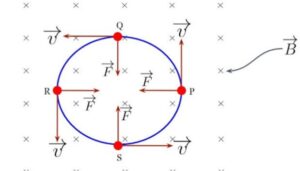Introduction
This is one of the important topics in AP Physics C E&M.
Charge feels force on it. The force is dependent on the charge (q), velocity(v)and magnetic field (B).
![]()
![]()
Let us consider this particle has a charge q and it moves in the direction of magnetic field B (motion in a magnetic field); the velocity is v and θ is the angle between B and V
We have different cases for a force experienced by a charge
CASE 1: if θ = 0 or 180
Velocity of charge is parallel or anti-parallel to magnetic field.
F= 0.
Trajectory = straight line.
CASE 2: if θ = 90
Velocity of charge is perpendicular to magnetic field
![]()
![]()
F = F centripetal
Trajectory = circle (right-hand thumb rule )

Biot savart law
Biot savart law is a fundamental relationship between an electric current I and the magnetic field B in physics.
Biot savart law equations describe the relationship between the magnetic field generated by a constant electric current. It relates the magnetic field to the magnitude, direction, length, and electric current.
![]()
dL = infinitesimal length of a conductor carrying electric current.

Magnetic Field
Magnetic Field is a region of space near a magnet.
In other words
A magnetic field is a field that describes the magnetic influence on moving electric charges and electric currents. A moving charge(q) in a magnetic field experiences a force perpendicular to its own velocity (v) and to the magnetic field. It can be denoted with B.
The electric field produced by a point charge q at rest at the origin is
![]()
Where F is Electrostatics Force, and q is point charge.
Magnetic field lines
The magnetic field lines are a visual and intuitive realisation of the magnetic field.
The Dipole in a uniform magnetic field
The magnetic field lines give us an
approximate idea of the magnetic field (B). To
determine the magnitude of B accurately. This is done by placing a small compass needle of known magnetic moment (m) and moment of inertia (I)
and allowing it to oscillate in the magnetic field.
The torque on the needle is
![]()
In magnitude
![]()
Here τ is restoring torque and θ is the angle between m and B.
To know more about the other chapters tested in AP Physics C E&M, Check out Succeeding in AP Physics C Electricity and Magnetism



